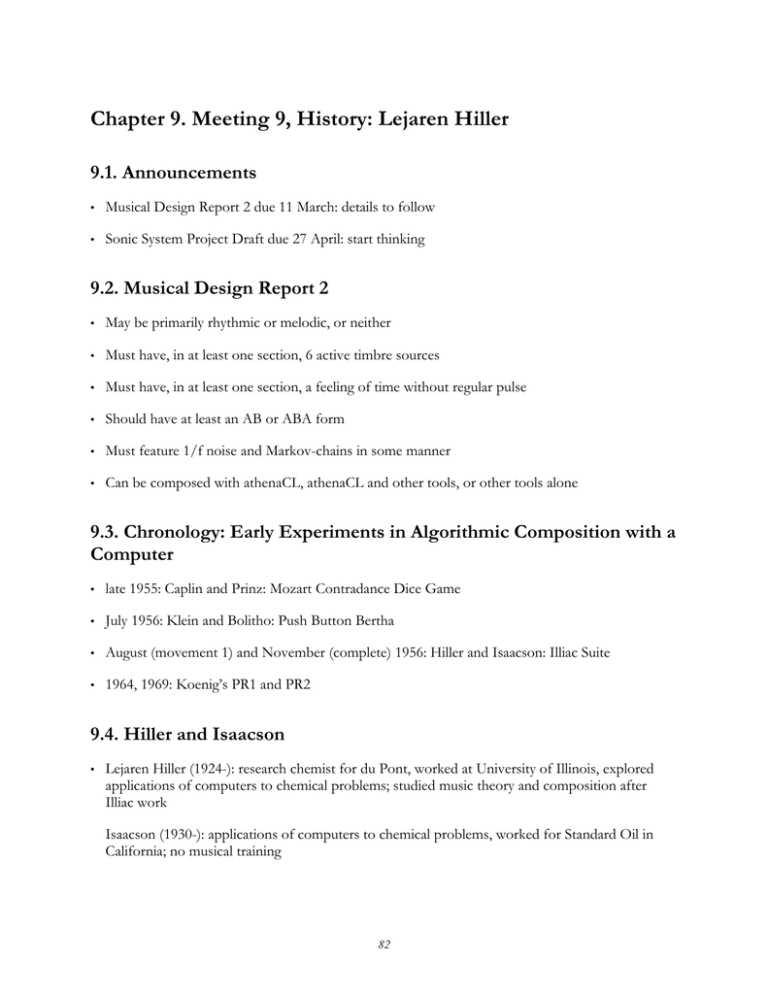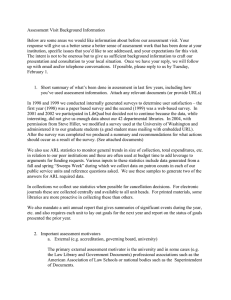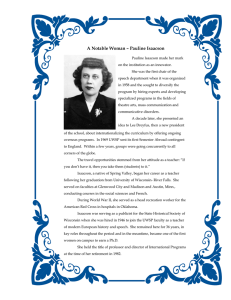
Chapter 9. Meeting 9, History: Lejaren Hiller
9.1. Announcements
•
Musical Design Report 2 due 11 March: details to follow
•
Sonic System Project Draft due 27 April: start thinking
9.2. Musical Design Report 2
•
May be primarily rhythmic or melodic, or neither
•
Must have, in at least one section, 6 active timbre sources
•
Must have, in at least one section, a feeling of time without regular pulse
•
Should have at least an AB or ABA form
•
Must feature 1/f noise and Markov-chains in some manner
•
Can be composed with athenaCL, athenaCL and other tools, or other tools alone
9.3. Chronology: Early Experiments in Algorithmic Composition with a
Computer
•
late 1955: Caplin and Prinz: Mozart Contradance Dice Game
•
July 1956: Klein and Bolitho: Push Button Bertha
•
August (movement 1) and November (complete) 1956: Hiller and Isaacson: Illiac Suite
•
1964, 1969: Koenig’s PR1 and PR2
9.4. Hiller and Isaacson
•
Lejaren Hiller (1924-): research chemist for du Pont, worked at University of Illinois, explored
applications of computers to chemical problems; studied music theory and composition after
Illiac work
Isaacson (1930-): applications of computers to chemical problems, worked for Standard Oil in
California; no musical training
82
Photo of L. A. Hiller and L. M. Isaacson removed due to copyright restrictions.
•
Used University of Illinois ILLIAC (ILLInois Automated Computer)
1952: ILLIAC, the first computer built and owned entirely by an educational institution
83
© source unknown. All rights reserved. This content is excluded from our Creative
Commons license. For more information, see http://ocw.mit.edu/fairuse.
•
Created four movements of a string quartet: Illiac Suite
•
Hiller describes the Illiac Suite as a “… presentation of sample results … in the form of a fourmovement transcription for string quartet” (1956, p. 248).
•
Published a complete book on the process: Hiller, L. and L. Isaacson. 1959. Experimental Music.
New York: McGraw-Hill.
•
Hiller went to continue to explore techniques of computer composition, including work with
John Cage
9.5. Reading: Hiller, L. and L. Isaacson. Musical Composition with a
High-Speed Digital Computer
•
Hiller, L. and L. Isaacson. 1958. “Musical Composition with a High-Speed Digital Computer.”
Journal of the Audio Engineering Society 6(3): 154-160.
84
•
Why do HIller and Isaacson think that music is well suited for this sort of computer experiment?
•
Did Hiller and Isaacson see their work as an experiment, or as a work of art?
•
What social and critical context is suggested by the discussion question, at the end of the article?
9.6. Hiller and Isaacson: Illiac Suite I and II
•
Strict counterpoint in the model of 18th century treatise Gradus ad Parnassum
•
Monte-carlo technique: random generative pitches and filter through rules
•
Borrowed programming models from previous work in chemistry
•
Generated only pitch; registration, instrumentation, dynamics, and rhythm manually applied
•
Flow chart of strict counterpoint
85
•
Courtesy of MIT Press. Used with permission. From Hiller, L., and L. Isaacson.
"Musical Composition with a High-Speed Digital Computer." In Machine Models
of Music. Edited by S. Schwanauer and D. Levitt. MIT Press, 1993.
Audio: Hiller: Illiac Suite, Experiment 1 and Experiment 2 (1956)
86
9.7. Monte Carlo: Concepts
•
Monte-Carlo: a wealthy quarter of the city-state Principality of Monaco, and host to European
Formula One racing, resorts, and gambling
•
1940s: John von Neuman and Stanislas Ulam: used to study problems of neutron diffusion at Los
Alamos in research relating to the hydrogen bomb
•
Random generation of values that are tested and then kept or discarded
•
Only feasible with the use of computers
•
Brute-force solutions
•
Good for problems where attributes of the answer are known, but how to get the answer is not
•
Also called statistical sampling; related to constraint satisfaction problems
9.8. Monte Carlo Melodic Generation with athenaCL Python Libraries
•
Produce a melody using 14 diatonic pitches, where intervals between steps are limited between
two values provided with command-line arguments
•
monteCarlo.py
import os, random, sys
from athenaCL.libATH import midiTools
from athenaCL.libATH import osTools
from athenaCL.libATH import pitchTools
from athenaCL.libATH import rhythm
from athenaCL.libATH.libOrc import generalMidi
from athenaCL.libATH.libPmtr import parameter
OUTDIR = '/Volumes/xdisc/_scratch'
BEATDUR = rhythm.bpmToBeatTime(128) # provide bpm value
def getInstName(nameMatch):
for name, pgm in generalMidi.gmProgramNames.items():
if name.lower().startswith(nameMatch.lower()):
return pgm # an integer
return None
def convertPitch(pitch, octShift=0):
midiPs = pitchTools.psToMidi(pitchTools.psNameToPs(pitch))
midiPs = midiPs + (12*octShift)
return midiPs
def genScore(minStep=1, maxStep=3):
pitchScale = {1:'C4', 2:'D4', 3:'E4', 4:'F4', 5:'G4', 6:'A4', 7:'B4',
8:'C5', 9:'D5',10:'E5',11:'F5',12:'G5',13:'A5',14:'B5', }
melodyLength = 36
melody = []
while True:
if len(melody) == melodyLength:
87
break
elif len(melody) == 0:
melody.append(1)
continue
else:
pitchLast = melody[-1] while True:
pitchNew = random.choice(pitchScale.keys()) interval = abs(pitchNew - pitchLast)
if interval >= minStep and interval <= maxStep:
melody.append(pitchNew)
break
else:
continue score = []
tStart = 0.0
for i in range(melodyLength):
pitch = convertPitch(pitchScale[melody[i]])
dur = BEATDUR * .5
amp = 90
pan = 63
event = [tStart, dur, amp, pitch, pan]
score.append(event)
tStart = tStart + dur
return score
def main(minStep, maxStep):
trackList = []
score = genScore(minStep, maxStep)
trackList.append(['part-a', getInstName('piano'), None, score])
path = os.path.join(OUTDIR, 'test.midi')
mObj = midiTools.MidiScore(trackList)
mObj.write(path) osTools.openMedia(path)
if __name__ == '__main__': if len(sys.argv) != 3:
print('required command-line arguments: minStep maxStep') else:
main(int(sys.argv[1]), int(sys.argv[2]))
9.9. Hiller and Isaacson: Illiac Suite III
•
Constrained chromatic music
•
Generated pitch, rhythm, amplitude, and performance articulation
•
Audio: Hiller: Illiac Suite, Experiment 3 (1956)
88
© Carl Fischer, LLC. All rights reserved. This content is excluded from our
Creative Commons license. For more information, see http://ocw.mit.edu/fairuse.
9.10. Hiller and Isaacson: Illiac Suite IV
•
Markov chains (zero and first order) for interval and harmony selection
89
•
Models from music theory (Schenker)
•
Only movement not produced from a combination of outputs
•
Tempo, meter, dynamics added manually
•
Audio: Hiller: Illiac Suite, Experiment 4 (1956)
9.11. Hiller and Isaacson: Issues and Responses
•
Cony, E. 1956. “Canny Computers: Machines Write Music, Play Checkers, Tackle New Tasks in
Industry.” Wall Street Journal 148(56)
90
© Wall Street Journal. All rights reserved. This content is excluded from our
Creative Commons license. For more information, see http://ocw.mit.edu/fairuse.
91
•
Brower, B. 1961. “Why ‘Thinking Machines’ Cannot Think.” New York Times February 19: 213.
Image and text quotes © New York Times. All rights reserved. This content is excluded
from our Creative Commons license. For more information, see http://ocw.mit.edu/fairuse.
•
“And finally -- to stretch the point as far as some of the computer people have done -- machines
are presumably capable of ‘creating works of art.’ in any case, Lejaren A Hiller Jr. and L. M.
Isaacson hold a copyright for their ‘Illiac Suite for String Quartet’ ...”
92
“this rather ludicrous extension of the machine-brain equation to artistic creativity perhaps best
illustrates its limitations. No machine is every really likely to contain the artist within its electro
physics, and to a greater or lesser degree, it is unlikely that machine equivalents will be
constructed for the highest of human attributes.”
“it is best to view the electronic brains as instruments of human calculation, which achieve results
that lie beyond human time and precision, but not beyond human intelligence”
9.12. Zero Order Markov Chains as ParameterObjects
•
A zero order Markov chain is weighted random selection
•
MarkovValue ParameterObject
:: tpv mv
Generator ParameterObject
{name,documentation}
MarkovValue
markovValue, transitionString, parameterObject
Description: Produces values by means of a Markov transition
string specification and a dynamic transition order
generator. Markov transition order is specified by a
ParameterObject that produces values between 0 and the
maximum order available in the Markov transition string. If
generated-orders are greater than those available, the
largest available transition order will be used. Floating- point order values are treated as probabilistic weightings:
for example, a transition of 1.5 offers equal probability of
first or second order selection. Arguments: (1) name, (2) transitionString, (3) parameterObject {order value}
•
•
The transition string
•
Two parts: symbol definitions and weights
•
Symbol definition: a{3}b{345}c{23.54}
•
Zero order weights: :{a=3|b=1|c=34}
MarkovValue: zero order with equal weighting
:: tpmap 100 mv,a{2}b{4}c{7}d{9}e{11}:{a=1|b=1|c=1|d=1|e=1}
markovValue, a{2}b{4}c{7}d{9}e{11}:{a=1|b=1|c=1|d=1|e=1}, (constant, 0)
TPmap display complete.
93
•
MarkovValue: zero order with stronger weightings on two values
:: tpmap 100 mv,a{2}b{4}c{7}d{9}e{11}:{a=1|b=6|c=1|d=9|e=1}
markovValue, a{2}b{4}c{7}d{9}e{11}:{a=1|b=6|c=1|d=9|e=1}, (constant, 0)
TPmap display complete.
9.13. Building a Self-Similar Melody
•
Self similar Markovian melody generation and transposition
•
Command sequence:
•
emo m
•
tin a 24
•
using 1/f noise for durations with ConvertSecond and Noise
tie r cs,(n,100,1.5,.100,.180)
•
a more dynamic timing offset
tie r cs,(om,(n,100,1.5,.100,.180),(ws,t,8,0,.5,1))
•
Markov weighted pitch transposition
tie f mv,a{2}b{4}c{7}d{9}e{11}:{a=1|b=6|c=1|d=9|e=1}
•
self-similar pitch transposition combing a grouped version of the same Markov generator with OperatorAdd
tie f oa,(mv,a{2}b{4}c{7}d{9}e{11}:{a=1|b=3|c=1|d=3|e=1}), (ig,(mv,a{2}b{4}c{7}d{9}e{11}:{a=1|b=3|c=1|d=3|e=1}),(ru,10,20))
•
Markov based octave shifting
tie o mv,a{-2}b{0}c{-2}d{0}e{-1}:{a=1|b=3|c=1|d=3|e=1}
•
A widening beta distribution
tie a rb,.2,.5,(ls,e,(ru,3,20),.5,1)
94
•
Modulated with a pulse wave (and random frequency modulation on the PulseWave)
tie a om,(rb,.2,.5,(ls,e,(ru,3,20),.5,1)),(wp,e,(ru,25,30),0,0,1)
•
tie t 0,120
•
eln; elh
9.14. Resuming PD Tutorial
•
PD Tutorial
95
MIT OpenCourseWare
http://ocw.mit.edu
21M.380 Music and Technology: Algorithmic and Generative Music
Spring 2010
For information about citing these materials or our Terms of Use, visit: http://ocw.mit.edu/terms.






